Neil Stubley - Courting the media!
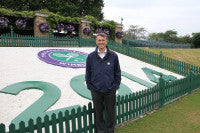
What does your role involve?
I am a Grounds Manager rather than a traditional Head Groundsman. I am charged with looking after all the grounds here at the All England Tennis Club, including the landscaping. We have six full-time gardeners on our books. We also have a sports facility at Raynes Park which comes under my remit. Here, there are grass courts, a cricket square and football pitches. So, as well as looking after the fifty-odd courts at Wimbledon, I am kept pretty busy!
What sports did you play?
I played a lot of tennis and football, and also cricket and rugby, although the latter seemed too violent for me! So I played a lot of sport growing up. Even to this day, I still play football and go running.
Have you ever played on the courts here?
Yes, when I was a young groundsman. The thing is, these courts are so fast that you have to be quite fit just to get around them. The ball comes through so quickly. Most people would be surprised at just how fast they are.
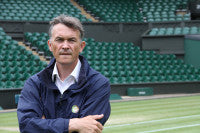
Pretty much by default. My mother used to work as the PA to Len Stocks, principal at Norwood Hall College. I was a teenager bored with my job and mum suggested that I went back to college, which I did. I took a one year, horticultural based course, which had sports turf attached to it. John Flood was my sports turf lecturer. He knew Eddie Seaward quite well, so managed to get myself and another lad a placement here in the 1995 season. Eddie used to take on half a dozen students a year, which is something I still do.
At the time, I didn't know that one of the full-time guys was retiring, so Eddie needed to find a replacement. Out of the six students, Eddie chose me. It was like I had gone from tea boy to the top!
I have worked my way up from an apprentice, to groundsman and then, in 2002, became senior groundsman. Any job that we do here I have done a million times, so if I ask the staff to carry out something, they know it's something I have done in the past. They appreciate that.
What has been the highlight of your career?
Oh, getting this job, without a doubt. When Eddie announced his retirement, it would have been quite easy for the club to employ someone from outside, because it was the simple thing to do. They told me that they were going to advertise the job worldwide, but that I was more than welcome to go for it!
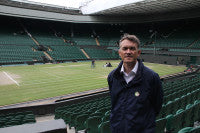
And, of course, working on the Olympics; two major sporting events in one year! It was a huge challenge for us. It took four years to fine tune just how we were going to cope with them being so close together. I felt really proud for our industry that we managed to pull it off. You don't get quality sport without quality surfaces.
I do quite a lot of media work, and I am glad I do, because it gives me the opportunity to talk about our surfaces and our industry; to explain just what goes into the preparation; that the players don't just rock up and play on something we have simply cut a few days before which had been laying fallow for most of the year! It's healthy, because they then gain an appreciation of the work involved.
I got offered the job in 2011, and it would have been very difficult for someone to come in here, not having experienced the Championships, regardless of how talented a groundsman they were. The club has always had a policy that, when you start as Head Groundsman Designate, you shadow the outgoing Head Groundsman for a year and, the following year, he shadows you. The fact that I had worked with Eddie for so many years did make that process easier though.

I think expectations. Every year that we produce fantastic surfaces we are expected to improve on them the next year. Now, that's no bad thing as it means we never get complacent. Even this year, during the Championships, we were identifying areas that we think we can improve on. Now, whether a player or the outside world would notice that, I'm not so sure, but in our minds, we know where we can improve.
And then there's the pressure of one billion people watching the tournament worldwide and judging your surfaces. You can't fail. The Championship has to start and finish. That's the bottom line.
Are there any developments planned and how might they affect you?
Plenty over the next few years; the roof on No 1 court, the relocation of some courts, making public flow much better, the development and relocation of our indoor centre, all the hard court and play courts are being relocated. All designed to allow us to move some of the grass courts to make the spectator and player experience better.
What relationship do you have with the players?
Very good. Tennis players are very down to earth people. Despite the fact that they are very good at their sport and make a lot of money out of it, if you actually talk to them they are generally very quiet and humble. We have a very good relationship with them. In the practice week running up to the tournament we are always asking them for feedback, whether that be good or bad, how they feel the courts are playing and so on. Then we digest what has been said and see if there is any merit in their comments. Sometimes, it might simply be personal perceptions or that grass doesn't suit that player's style of play, but we have to take it all on board.
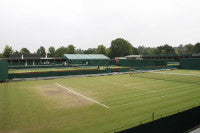
That comes under the ITF (International Tennis Federation) and is stringently checked before the Championships. Styles of play is the issue. Some of the players are bringing their clay court game to the grass court season. Someone like Novak Djokovic can slide into shots and recover, whereas some other players might become off balance.
Which is why, in the last couple of years, the media has called the surface into question but, if you look at the players that were actually slipping, it was the style of their footwork that was the issue, not the surface. So, that is one area we will have to look at. How can we adapt to better suit the modern day tennis player and how might they adapt to the modern day grass court? It's a relationship between the two.
Is there one player that has made an impact on you?
Roger Federer. He is the most gracious, perfect tennis player I have seen play here. His footwork is a fine example of what we were talking about. Even in the final, his footwork was perfect for grass; he has such good balance and grace, whereas Novak continued to play more in the clay court style. As he won, I doubt he cares though!
I was surprised it went to five sets, to be honest, as Roger had a reasonably comfortable run through the draw, whereas Novak had a few four set matches, so I was expecting Federer to win. But it was great to be part of a final that everyone will be talking about for some time yet.
Without blowing our own trumpet, the tennis court had a part to play in that. Whilst there was wear behind the baseline, the actual playing surface was 95% grass. There were no bad bounces and the surface was very consistent, which suited both their games.
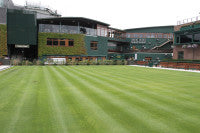
It has to be the weather. No two years are ever the same and it seems to be getting more and more unpredictable. This year, we had a fairly decent April and then, from mid May into June, we had mid-teens temperatures and lots of surface moisture. So, we are having to adapt more to produce quality surfaces, which is a challenge. This was my twentieth tournament and I don't think we have ever had two years that have been the same. The last four years have certainly been 'chalk and cheese'.
Do the TV pundits and press folk talk commonsense? For example, some have criticised the changes made to the courts at Wimbledon
You have to take it with a pinch of salt. We had an incident this year during the Djokovic/Dimitrov match where both players were sliding into shots, so the potential for a slip was always there. John McEnroe suggested that we should water the baselines in between sets like they do at the French Open. I don't know whether that was tongue in cheek or not, but then I get a phone call from the press office telling me there's thirty journalists that want to talk to me about watering the baselines! It's comments like that which don't help us, but we don't take it to heart. Conversely, when the same people praise the courts, we don't get carried away. We are a very level headed bunch.
Journalists will always have a story to write, and we have to accept that. We are one of the biggest sporting events in the world, so that comes with the territory.

Perhaps, but you have to remember that they are on the circuit all year round and only here for two weeks, so they don't see what goes on. I speak to journalists and commentators as often as I can and explain about hardness readings, grass coverage, grass cultivars and the reasons behind these choices. So, hopefully, I am giving them a little bit more education each time. There'll always be the cavalier journalist looking for sensation over fact, but the majority are fine.
Is there anything you would have done differently, professionally and personally?
No, not really. I am in a very good place at the moment. I enjoy my job; it's very varied. I'm fortunate enough to work at one of the top turf venues in the world. I'm very privileged and humbled by that. I'm only the eighth head groundsman in the almost 150 year history of the club, so to have the responsibility of moving the surfaces forward over the next fifteen or twenty years is exciting but, as Eddie always used to say, "you are only as good as the team around you", and I have a really good team who all know what they are doing. Even without me they would continue to do it; but me without them? I couldn't do it. That pretty much sums it up.
How has groundsmanship changed in your time and how can we raise our profile?
It's become far more professional. I can remember that, when I went to Saltex twenty years ago, it looked like most of the groundsmen were about to head off to the allotments. Now, we are much better presented, and rightly so. As far as I'm concerned, a groundsman is equally as important as any other staff member - IT, CEO or directors - and the playing surfaces are the lifeblood of the facilities, so we should present ourselves accordingly, which we are now doing.
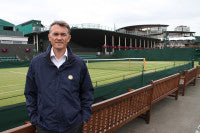
Moving on to the Championships; how many staff work during the tournament?
It's the same as normal. We have our sixteen core groundstaff, two of whom are mechanics and two irrigation engineers. In April, we will supplement this with an additional twelve staff, some of whom return regularly. For example, we've got one guy who specialises in bowls greens. He heads off working around the world from October and then comes back to us in spring. He's fitted in really well and understands our ethos. Having people like him means they already know the ropes.
We also have three or four students, just so we can gauge what's out there. It also helps them. I know this is Utopia for some, and they may get a shock when they enter the real world, but it shows what they can work towards and how well the British groundsman can put on these events. If they get the bug and want to stay in the industry, then we have done our job.
Some of the guys come from other sports and/or abroad and often come with fresh ideas. We are not a closed shop and always welcome their input.
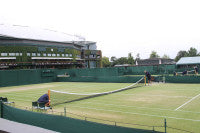
Once the Championships start, there's not a lot we can do. Each morning we cut and mark out the Championship courts and this process is repeated on the practice courts in the evening. The STRI are here for the week preceding and during the tournament and they provide us with daily readings on such things as Clegg hammer tests and chlorophyll levels, which we can then analyse to assist us with watering levels, hardness and such like.
Much of what we do is governed by the weather and the players. Are they toe draggers or sliders, how long did the match last? For example, the ladies final lasted under an hour; the men's for four hours. There's a lot of variables, which is part of the enjoyment of the job. It's not like a football match that only lasts for ninety-odd minutes.
Do you water the courts during the Championships?
We have to water every evening. It's a case of enough to replenish the surface, but be dry enough for play the next day. It's a fine line. We have a benchmark for water in the soil profile from day one, so it's a case of keeping that topped up.

What are your feeding regimes?
This winter, we did a couple more autumn/winter granular feeds than we would normally do because of the weather. Purely because of the amount of rain that was going through and, even with our clay soils, leaching was up on normal. From April onwards we enter our Primo Maxx programme, which includes a liquid feed, iron and amino acids, plus the odd granular feed.
Since we've gone to 100% ryegrass, we've noticed that our feeding regimes have gone up, purely because of the demands of ryegrass. It's a catch 22. To have 100% ryegrass tennis courts gives you the strongest possible playing surfaces but, to achieve that, you are giving the grasses the one thing that poa annua loves, which is high nitrogen. That's now our biggest battle. We've had the stats back and they show, at worst, 2.7% poa, which is a far cry from prior to fraise mowing, when it was more like 50/50. At 2.7%, alarm bells will start to ring for us and, even at 1.5% we are thinking how can we get that down?

To some visitors, they are as important as the tennis. Many come here just to see the displays. We get fantastic feedback. We used to use a contractor, but now everything is done by our in-house team.
Who chooses the colour schemes?
We still use our old horticultural consultant with regards to design, whilst a contractor will bring in all the tubs and troughs, but we do the rest. Much like the courts, we look for constant improvement. We might change 20% of the planting schemes each year, but not the same 20% each time, so there is constant improvements going on.
After the Championships, are Centre and No 1 courts used?
Not a lot really. The chairman of the club uses the Centre Court for one day for invited guests but, after that, we put on a total weedkiller and glyphosate and, seven to ten days later, we'll begin the fraise mowing process. The reason we do that so early is because of their stadium environments. We need to get the grasses established as soon as possible going into the autumn. It also helps us to stay on track. We have forty-one grass courts to renovate and only a small window of opportunity.

Apart from Centre and No 1, all courts open for play in May, but at a time when I consider them fit for play. All courts, including the tournament courts, are available to members up until 7.00pm on the Friday before the Championships, which is lovely for them as the professionals are practising at the same time. Even the pros have to book the courts as our members do. It's one of the quaint things we do here.
We are given seventy-two hours grace after the Championships, by the members, to get the courts ready for play again.
What's a typical day for you during the Championships?
I'm usually up about 5.30 in the morning. We have a team of four who stay overnight to make sure that any weather issues don't affect the courts. I check with them to see if everything is okay and arrive at the club about 6.45am. If the weather is okay, we'll deflate and take off all the covers and begin cutting, marking out and rolling. That is completed by 10.00am and they all head off for breakfast. The gates open to the public at 10.30am.
We then get into our uniforms and set up the courts for play. Once play has started, there's not a lot we can do. We will make sure that the nets are as tight as they should be and then, at around 5.00pm, my deputy, Grant, and I will go through all the day's collected data, check the weather forecast, check the hardness data and decide how much water we need to put on each court; they are all individually assessed.
What gravities are you working to?
We like to start the tournament at around 200. If we can maintain that then we know we'll have decent hardness, good ball bounce and the grass won't be too stressed out but, during the week, it will creep up to somewhere around 250.
Wimbledon is the only grand slam tournament that doesn't host play on the middle Sunday, and I know there was some discussion about this, but you have to also remember that we are the only grand slam dealing with a living surface.
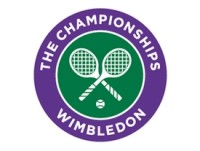
But numbers will go up if the weather is very hot, as it was this year, possibly by 10 a day, and watering will only reduce it by 4, so that is why having a strong sward at the beginning of the tournament is so vitally important.
In truth, the players probably wouldn't notice, but the readings are a good benchmark for us; and they are independent, so that we can show the outside world if needs be.
Thank you for a fascinating insight into your work.
